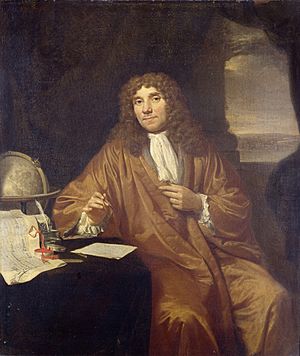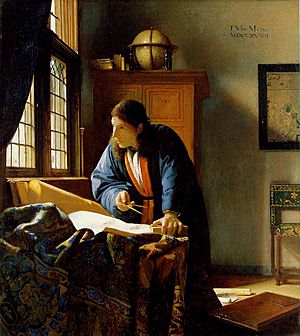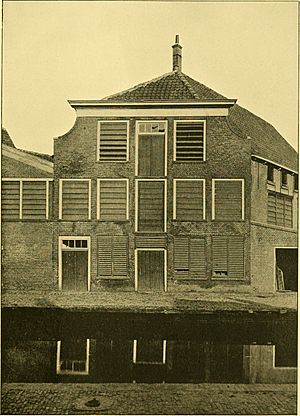Antonie van Leeuwenhoek facts for kids
Quick facts for kids
Antonie van Leeuwenhoek
|
|
|---|---|

A portrait of Antonie van Leeuwenhoek (1632–1723) by Jan Verkolje
|
|
| Born | 24 October 1632 |
| Died | 26 August 1723 (aged 90) Delft, Dutch Republic
|
| Nationality | Dutch |
| Known for | The first acknowledged microscopist and microbiologist in history Microscopic discovery of microorganisms (animalcule) |
| Scientific career | |
| Fields | Microscopy Microbiology |
| Influences | Robert Hooke Regnier de Graaf |
| Influenced | History of biology and life sciences Natural history Scientific Revolution Age of Reason |
| Signature | |
Antonie Philips van Leeuwenhoek (born October 24, 1632 – died August 26, 1723) was a Dutch scientist. He is often called "the Father of Microbiology." He was one of the first people to use microscopes to study tiny living things.
Van Leeuwenhoek made important discoveries in microscopy. He helped make microbiology a real science. He was born in Delft, in the Dutch Republic. He worked as a cloth merchant when he was young. Later, he started his own shop in 1654.
He became interested in making lenses. In the 1670s, he began looking at tiny life forms with his own microscopes. This was a big achievement during the Dutch Golden Age.
Van Leeuwenhoek used microscopes he designed himself. These microscopes had a single lens. He was the first to see and study microbes. He called them dierkens, which means "small animals." Today, we call most of these "animalcules" or unicellular organisms. He was also the first to see muscle fibers, bacteria, red blood cells, and blood flowing in tiny capillaries.
He wrote letters about his discoveries to the Royal Society in London. Many of his letters were published.
Contents
Early Life and Work
Antonie van Leeuwenhoek was born in Delft, Dutch Republic, on October 24, 1632. His father was a basket maker who died when Antonie was five. His mother came from a family of brewers.
When he was about ten, his stepfather died. He went to school briefly. Then he lived with his uncle, who was a lawyer. At 16, he became an apprentice at a cloth shop in Amsterdam. He worked there for six years.
In 1654, van Leeuwenhoek married Barbara de Mey. They had one daughter, Maria. Four other children died when they were babies. He moved back to Delft that same year. He opened his own cloth shop.
His first wife died in 1666. In 1671, he married Cornelia Swalmius. They did not have children. Van Leeuwenhoek became important in Delft. In 1660, he got a good job as a chamberlain for the city hall. He held this job for almost 40 years. He also worked as a land surveyor and an official "wine-gauger." This meant he checked wine imports and taxes.

Van Leeuwenhoek lived at the same time as the famous painter Johannes Vermeer. Vermeer was also from Delft. Some people think van Leeuwenhoek might be in Vermeer's paintings, The Astronomer and The Geographer. However, they don't look very much alike. Since both were important men in a small city, they probably knew each other. Van Leeuwenhoek even helped manage Vermeer's will after the painter died in 1675.
Studying the Microscopic World
Van Leeuwenhoek ran his cloth shop. He wanted to see the quality of threads better. The magnifying glasses at the time were not good enough. This made him interested in making lenses.
He found a way to make very small, high-quality glass lenses. He would heat a glass rod and pull it apart. Then he would melt the end of a thin glass piece to make a tiny lens. For less powerful lenses, he also ground them. He kept his lens-making methods secret. He wanted people to think he only ground lenses.
Being Recognized by the Royal Society
After making his powerful lenses, van Leeuwenhoek started studying the tiny world. He showed his work to his friend, Reinier de Graaf, a Dutch doctor. The Royal Society in London was a famous scientific group. They published a journal called Philosophical Transactions of the Royal Society.
De Graaf wrote to the journal's editor, Henry Oldenburg. He praised van Leeuwenhoek's microscopes. He said they were much better than any seen before. In 1673, the Royal Society published a letter from van Leeuwenhoek. It described his observations of mold, bees, and lice.
The Royal Society was very interested. Van Leeuwenhoek began writing to them often. At first, he didn't want to share his findings. He thought he was just a businessman, not a scientist. But de Graaf encouraged him.
By the time he died, van Leeuwenhoek had written about 190 letters to the Royal Society. He described his discoveries in many fields. He only wrote in Dutch, his own language. He never wrote a formal scientific paper in Latin. He liked to work alone.
Henry Oldenburg translated his letters into Latin or English. Oldenburg also used the word animalcules to describe the tiny creatures van Leeuwenhoek saw.
At first, the Royal Society was doubtful. In 1676, van Leeuwenhoek sent them his first observations of single-celled organisms. No one knew these tiny creatures existed before. Even with his good reputation, his findings were met with some doubt.
But van Leeuwenhoek insisted. So, the Royal Society sent a group of people to Delft. They wanted to see if his observations were real. Finally, in 1677, his discoveries were fully accepted by the Royal Society.
In February 1680, Antonie van Leeuwenhoek was elected to the Royal Society. This was a great honor for him. He never went to the induction ceremony in London. He also never attended a Royal Society meeting.
Becoming Famous in Science
By the late 1600s, van Leeuwenhoek was almost the only person studying the microscopic world. Other scientists, like Robert Hooke, felt that one person was doing all the work. Many important people visited van Leeuwenhoek. This included the Russian Tsar Peter the Great.
However, van Leeuwenhoek disappointed his visitors. He refused to show them his best microscopes. These were the ones he used for his amazing discoveries. Instead, he showed them a collection of average lenses.
He was visited by Gottfried Leibniz, William III of Orange and his wife, Mary II of England. They all looked at his "tiny creatures." In 1698, he showed Tsar Peter the Great an "eel-viewer." This let the Tsar study blood flow whenever he wanted.
Methods and Discoveries
Antonie van Leeuwenhoek made over 500 lenses. He also built at least 25 single-lens microscopes. Only nine of these microscopes still exist today. They were made of silver or copper frames. They held his handmade lenses.
The microscopes that survived can magnify things up to 275 times. Some people think he had microscopes that could magnify up to 500 times. Even though he was not a formally trained scientist, his research was very good.
Van Leeuwenhoek's single-lens microscopes were small. The biggest was about 5 cm long. To use them, you held the lens very close to your eye. You looked towards the sun. The other side of the microscope had a pin. The sample was placed on this pin, close to the lens. There were also three screws. These screws moved the pin and the sample. This allowed him to focus and move around the sample.
Van Leeuwenhoek always kept his lens-making methods secret. For many years, no one could figure out how he made his lenses. But in 1957, C. L. Stong found a way. He used thin glass threads and melted them. This created working samples of van Leeuwenhoek's microscope design.
Van Leeuwenhoek counted microorganisms in water samples. He used his special method to study many tiny things. He shared his observations with groups like the British Royal Society. This work made him one of the most important explorers of the microscopic world. He was also one of the first to observe cells, like Robert Hooke.
Van Leeuwenhoek's main discoveries include:
- infusoria (tiny water creatures, now called protists), in 1674.
- Bacteria (like large ones from the human mouth), in 1683.
- The vacuole inside cells.
- The striped pattern of muscle fibers, in 1682.
In 1687, van Leeuwenhoek studied coffee beans. He roasted a bean and cut it. He saw a spongy inside. When he pressed the bean, oil came out. He also boiled coffee with rainwater.
Van Leeuwenhoek was also the first to use a histological stain. He used saffron to color specimens. This helped him see them better under the microscope.
He was a Calvinist Christian. He often spoke about the wonders God created in all creatures, big and small. He believed his discoveries showed more proof of God's amazing creation.
Legacy and Recognition
By the end of his life, van Leeuwenhoek had sent about 560 letters to the Royal Society. He also sent letters to other scientific groups. These letters were about his observations and discoveries. Even in his last weeks, he kept sending letters. His last letters described his own illness. He had a rare disease that caused uncontrolled movements. It is now called van Leeuwenhoek's disease. He died at 90 years old on August 26, 1723. He was buried in the Oude Kerk in Delft.
In 1981, a British microscopist named Brian J. Ford found van Leeuwenhoek's original specimens. They were in the Royal Society's collections. They were in good condition. Ford studied them with single-lens microscopes. He learned more about van Leeuwenhoek's work. Ford believed that van Leeuwenhoek was a careful and hardworking observer. He did proper experiments. He was also willing to change his mind if new evidence appeared.
Nick Lane, a British biochemist, wrote about van Leeuwenhoek's importance. He said van Leeuwenhoek was "the first even to think of looking." He was also "the first with the power to see." His experiments were clever. He was "a scientist of the highest calibre." Some people were jealous of him. Others looked down on him because he wasn't formally educated. His secrecy about his methods didn't help either.
The Antoni van Leeuwenhoek Hospital in Amsterdam is named after him. It specializes in treating cancer. In 2004, a poll in the Netherlands asked people to name the greatest Dutchman. Van Leeuwenhoek was voted the 4th greatest Dutchman of all time.
On October 24, 2016, Google celebrated his 384th birthday. They made a Google Doodle showing his discovery of "little animals" or animalcules. These are now known as bacteria.
Many things are named after him. These include the Leeuwenhoek Medal, the Leeuwenhoek Lecture, a crater on the Moon, and several scientific names.
Images for kids
-
A drawing by van Leeuwenhoek of a microscopic section of a one-year-old ash tree wood.
-
Drawings of van Leeuwenhoek's microscopes by Henry Baker.
-
Memorial of Antonie van Leeuwenhoek in the Oude Kerk in Delft.
-
A cluster of Escherichia coli bacteria magnified 10,000 times.
See also
 In Spanish: Anton van Leeuwenhoek para niños
In Spanish: Anton van Leeuwenhoek para niños
- Animalcule
- Regnier de Graaf
- Dutch Golden Age
- History of microbiology
- History of microscopy
- History of the microscope
- Robert Hooke
- Microscopic discovery of microorganisms
- Microscopic scale
- Science and technology in the Dutch Republic
- Scientific Revolution
- Nicolas Steno
- Jan Swammerdam
- Timeline of microscope technology
- Johannes Vermeer










